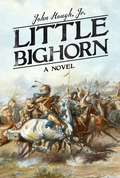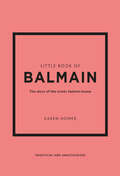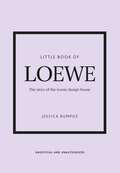- Table View
- List View
Little Bighorn, Tiospaye, The (Images of America)
by Kenneth Shields Jr.In June of 1876, members of various northern Plains tribes gathered at the Little Bighorn River to form the largest Indian encampment in recorded American history. The huge gathering, called Tiospaye, encompassed over 1,000 lodges housing approximately 7,000 men, women, and children. The over 200 vintage photographs portrayed here represent the weeks just before the infamous Battle of Little Bighorn and the creation of legends. Two major events occurred in June 1876 that would forever alter the course of Native American history. The defeat of Custer and the Seventh Cavalry was the most infamous event, but only the ending to a greater celebration. Offering a portrait of a people at the renaissance of their culture, this new book showcases images of the lifestyle of the encampment and the many brave leaders who fought at Little Bighorn, including Sitting Bull and the author's grandfather, Feather Earring.
Little Bighorn: A Novel
by John Hough Jr.Eighteen year-old Allen Winslow is living what should be every young man’s dream. Thanks to his mother’s charming intercession, he is to ride with the legendary Seventh Cavalry led by Gen. George Custer himself. Traveling west, he meets Addie Grace Lord, whose brother is one of Custer’s regimental surgeons, and the pair falls in love on their journey. As much as Allen wants to make something of himself on the untamed frontier, he soon wants to stay with Addie even more. But neither Allen nor Addie can know where their destinies lie—and neither can foresee the epic events about to tear them asunder. Beautifully written and filled with unforgettable characters both fictional and factual, Little Bighorn brings the American West and its heartbreaking history to life, brilliantly portraying the flawed and tormented Custer.
Little Bird of Auschwitz: How My Mother Escaped Death and Found Our Family
by Jacques Peretti'That nickname . . .''"Little bird." It wasn't mine. I found out later he gave it to every little girl that came in to be injected. "Little Bird" didn't mean anything. It was a trick. There were thousands of "little birds", just like me, all thinking they were the only one.'As a reporter, Jacques Peretti has spent his life investigating important stories. But there was one story, heard in scattered fragments throughout his childhood, that he never thought to investigate. The story of how his mother survived Auschwitz.In the few last months of the Second World War, thirteen-year-old Alina Peretti, along with her mother and sister, was one of thirteen thousand non-Jewish Poles sent to Auschwitz. Her experiences there cast a shadow over the rest of her life.Now ninety, Alina has been diagnosed with dementia. Together, mother and son begin a race against time to record her memories and preserve her family's story. Along the way, Jacques learns long-hidden secrets about his mother's family. He gains an understanding of his mother through retracing her past, learning more about the woman who would never let him call her 'Mum'.
Little Bird of Auschwitz: How My Mother Escaped Death and Found Our Family
by Jacques Peretti'That nickname . . .''"Little bird." It wasn't mine. I found out later he gave it to every little girl that came in to be injected. "Little Bird" didn't mean anything. It was a trick. There were thousands of "little birds", just like me, all thinking they were the only one.'As a reporter, Jacques Peretti has spent his life investigating important stories. But there was one story, heard in scattered fragments throughout his childhood, that he never thought to investigate. The story of how his mother survived Auschwitz.In the few last months of the Second World War, thirteen-year-old Alina Peretti, along with her mother and sister, was one of thirteen thousand non-Jewish Poles sent to Auschwitz. Her experiences there cast a shadow over the rest of her life.Now ninety, Alina has been diagnosed with dementia. Together, mother and son begin a race against time to record her memories and preserve her family's story. Along the way, Jacques learns long-hidden secrets about his mother's family. He gains an understanding of his mother through retracing her past, learning more about the woman who would never let him call her 'Mum'.(P) 2022 Hodder & Stoughton Limited
Little Bird of Auschwitz: How My Mother Escaped Death and Found Our Family
by Jacques Peretti'That nickname . . .''"Little bird." It wasn't mine. I found out later he gave it to every little girl that came in to be injected. "Little Bird" didn't mean anything. It was a trick. There were thousands of "little birds", just like me, all thinking they were the only one.'As a reporter, Jacques Peretti has spent his life investigating important stories. But there was one story, heard in scattered fragments throughout his childhood, that he never thought to investigate. The story of how his mother survived Auschwitz.In the few last months of the Second World War, thirteen-year-old Alina Peretti, along with her mother and sister, was one of thirteen thousand non-Jewish Poles sent to Auschwitz. Her experiences there cast a shadow over the rest of her life.Now ninety, Alina has been diagnosed with dementia. Together, mother and son begin a race against time to record her memories and preserve her family's story. Along the way, Jacques learns long-hidden secrets about his mother's family. He gains an understanding of his mother through retracing her past, learning more about the woman who would never let him call her 'Mum'.
Little Black Girl Lost
by Keith Lee JohnsonJohnnie Wise was just fifteen years old when her mother sold her virginity to an unscrupulous white insurance man named Earl Shamus. Stunningly beautiful, with long naturally wavy black hair, she possessed the voluptuous body of a thirty-year-old woman. Her skin was the color of brown sugar. Johnnie had heard about Earl Shamus and his escapades among the poor black women in New Orleans. But what she didn't know was that Shamus had quietly made several of the girls in their neighborhood his reluctant concubines when their youthful bodies ripened--she was next. Enter 1950's New Orleans, a world of betrayal, envy, lust and murder, where everyone has ulterior motives. Take a peek at Johnnie Wise, a 15-year-old girl, being pursued by ruthless crime boss, Napoleon Bentley, who will stop at nothing to have this young beauty. Little Black Girl Lost will shock you right up to the very end with its revealing truths.
Little Black Girl Lost 3: Ill Gotten Gains
by Keith Lee JohnsonThe past resurfaces in the third instalment of the life and times of 17-year-old Johnnie Wise. Truth has its consequences and Johnnie has a lot to answer for - the innocent girl from the first tale is gone and all that remains is the self-absorbed, self-righteous courtesan who is now complicit in three murders. Keith Lee Johnson takes readers back to 1950s New Orleans and into a world of betrayal, envy, lust and murder where everyone has ulterior motives.
Little Black Girl Lost 4: The Diary of Josephine Baptiste
by Keith Lee JohnsonFans of the Little Black Girl Lost series have become fascinated by the complex character of Johnnie Wise. In this fourth installment of the series, author Keith Lee Johnson takes us all the way back to the beginning, to the root of Johnnie's family tree ... In an African village, a beautiful 16-year-old girl is preparing to wed a much older man, but her heart belongs to his younger brother. Determined to be together, she and her young lover run away on the night before the arranged marriage is to take place. They have no idea that this is the last time they will ever see their families, their friends, or their beloved country. Before they can consummate their relationship, they are captured and brought on board a Dutch slave ship headed for the Americas. The young woman awakes in a new place, where she is given a new name. She is sold to a wealthy New Orleans plantation owner with some very peculiar tastes. Will she find a way to be reunited with her lover, or discover that lust, lies, and murder are a new way of life to which she must adapt?
Little Blog on the Prairie
by Cathleen Davitt BellThirteen-year-old Genevieve's summer at a frontier family history camp in Laramie, Wyoming, with her parents and brother is filled with surprises, which she reports to friends back home on the cell phone she sneaked in, and which they turn into a blog.
Little Bones
by Janette JenkinsIt's 1899 and a young girl is abandoned in London by her feckless family. She finds lodging and work assisting a doctor. But Jane Stretch is no ordinary girl, and Mr Swift is no ordinary doctor.Jane does her best to keep up with the doctor, her twisted bones throbbing, as they hurry past the markets, stage doors and side shows to appointments in certain boarding houses across town. The young actresses who live there have problems, and Mr Swift does what is required, calmly and discreetly. Grateful to her benefactor and his wife, Jane assists him and asks no questions - the desperate women not minding that it is a cripple girl who wipes their brows.When this unlikely pair becomes involved with Johnny Treble, a rakish music hall star, and the police come knocking, it seems that Jane's spell of good fortune is unlikely to last...
Little Book of Balmain: The story of the iconic fashion house (Little Book Of Fashion Ser.)
by Karen Homer"Good fashion is evolution, not revolution" – Pierre BalmainOne of the original big Parisian couture houses, alongside the likes of Dior and Chanel, Pierre Balmain reigned supreme over the 1950s fashion world with his spectacular and intricate evening wear.Now, in the twenty-first century, Balmain's ultra-modern look – still with the spirit of Pierre – is worn by the likes of Beyoncé, Kristen Stewart, Kate Moss and Kendall Jenner. Heavily embellished, dazzling detail meets futuristic silhouettes for an instantly recognisable look.Known for their strong social media presence driven by their "Balmain army" of fans, Balmain holds a unique position among the top couture houses today.
Little Book of Balmain: The story of the iconic fashion house (Little Book Of Fashion Ser.)
by Karen Homer"Good fashion is evolution, not revolution" – Pierre BalmainOne of the original big Parisian couture houses, alongside the likes of Dior and Chanel, Pierre Balmain reigned supreme over the 1950s fashion world with his spectacular and intricate evening wear.Now, in the twenty-first century, Balmain's ultra-modern look – still with the spirit of Pierre – is worn by the likes of Beyoncé, Kristen Stewart, Kate Moss and Kendall Jenner. Heavily embellished, dazzling detail meets futuristic silhouettes for an instantly recognisable look.Known for their strong social media presence driven by their "Balmain army" of fans, Balmain holds a unique position among the top couture houses today.
Little Book of Bottega Veneta: The story of the iconic fashion house (Little Book Of Fashion Ser.)
by Frances Solá-SantiagoSynonymous with fine craftsmanship and understated elegance, the House of Bottega Veneta is the go-to brand for those who love effortless chic.Since 1966, Bottega Veneta has stood out from the crowd, unique in its blend of timeless sophistication and contemporary edge. Known for the distinctive Intrecciato woven design and statement green, this Milan-based luxury brand is renowned for beautifully-crafted leather goods such as the Cabat, Veneta, and iconic clutch Knot bags and increasingly famous footwear and jewellery collections.Cultural relevance remains at the heart of this ultra-cool brand with the likes of Nicole Kidman, Cameron Diaz and Rihanna seen in exquisite hand-finished dresses, oversized clutches and quilted shoes. Under Creative Director, Matthiew Blazy, there's no denying that Bottega Veneta is one of the most exciting brands in the fashion world.
Little Book of Bottega Veneta: The story of the iconic fashion house (Little Book Of Fashion Ser.)
by Frances Solá-SantiagoSynonymous with fine craftsmanship and understated elegance, the House of Bottega Veneta is the go-to brand for those who love effortless chic.Since 1966, Bottega Veneta has stood out from the crowd, unique in its blend of timeless sophistication and contemporary edge. Known for the distinctive Intrecciato woven design and statement green, this Milan-based luxury brand is renowned for beautifully-crafted leather goods such as the Cabat, Veneta, and iconic clutch Knot bags and increasingly famous footwear and jewellery collections.Cultural relevance remains at the heart of this ultra-cool brand with the likes of Nicole Kidman, Cameron Diaz and Rihanna seen in exquisite hand-finished dresses, oversized clutches and quilted shoes. Under Creative Director, Matthiew Blazy, there's no denying that Bottega Veneta is one of the most exciting brands in the fashion world.
Little Book of Celine: The story of the iconic fashion house (Little Books of Fashion)
by Frances Solá-SantiagoTimeless, elegant and innovative, Celine sits at the intersection of high fashion and minimal sophistication.Beginning with the origins of the house in 1940s Paris and coming right up to Hedi Slimane's current stewardship, Phoebe Philo's groundbreaking years at the brand are also covered in depth, with every significant piece unpacked, including the glove shoe, furry sliders, the pyjama shirt and the Trapeze bag.With 100 stunning images and expert text, Little Book of Celine tells the whole story of a sophisticated luxe sportswear brand whose designs have become cult classics.
Little Book of Celine: The story of the iconic fashion house (Little Books of Fashion)
by Frances Solá-SantiagoTimeless, elegant and innovative, Celine sits at the intersection of high fashion and minimal sophistication.Beginning with the origins of the house in 1940s Paris and coming right up to Hedi Slimane's current stewardship, Phoebe Philo's groundbreaking years at the brand are also covered in depth, with every significant piece unpacked, including the glove shoe, furry sliders, the pyjama shirt and the Trapeze bag.With 100 stunning images and expert text, Little Book of Celine tells the whole story of a sophisticated luxe sportswear brand whose designs have become cult classics.
Little Book of Chanel (Little Books of Fashion)
by Emma Baxter-Wright WelbeckLittle Book of Chanel is the pocket-sized and beautifully illustrated story of the most celebrated fashion designer in history. Chronicling the life and legacy of Coco Chanel, one of fashion's most influential couturiers, this gorgeous book offers a fascinating account of Chanel's evolution and innovation. From her early days of millinery, through her revolutionary inventions in sportswear and jersey fashions for women, to the classics that made her name, such as the Chanel cardigan jacket, little black dress and exquisite perfumes. Detailed photographs and sketches of Chanel's designs, along with fashion photography and catwalk shots, pay tribute to one of the world's most highly regarded fashion houses and the woman behind it, making a striking gift for any lover of fashion.
Little Book of Chanel (Little Books of Fashion)
by Emma Baxter-Wright WelbeckLittle Book of Chanel is the pocket-sized and beautifully illustrated story of the most celebrated fashion designer in history. Chronicling the life and legacy of Coco Chanel, one of fashion's most influential couturiers, this gorgeous book offers a fascinating account of Chanel's evolution and innovation. From her early days of millinery, through her revolutionary inventions in sportswear and jersey fashions for women, to the classics that made her name, such as the Chanel cardigan jacket, little black dress and exquisite perfumes. Detailed photographs and sketches of Chanel's designs, along with fashion photography and catwalk shots, pay tribute to one of the world's most highly regarded fashion houses and the woman behind it, making a striking gift for any lover of fashion.
Little Book of Chloé: The story of the iconic brand (Little Books of Fashion)
by Caroline YoungRomantic, cool and glamorous, the Chloé woman embodies the bohemian femininity that the fashion house has become known for.From the carefree romanticism of their relaxed silhouettes to their cult status leather goods, Chloé has appealed to the modern woman since its inception in 1952. Founded by Gaby Aghion, who introduced the revolutionary concept of ready-to-wear, the maison has since been steered by legendary designers including Karl Lagerfeld, Phoebe Philo and Stella McCartney.Including carefully curated images of Chloé's most sought-after pieces as well as captivating text, Little Book of Chloé tells the story behind an iconic fashion house from its beginnings in Paris through to its continued status as the It-girl design house today.
Little Book of Chloé: The story of the iconic brand (Little Books of Fashion)
by Caroline YoungRomantic, cool and glamorous, the Chloé woman embodies the bohemian femininity that the fashion house has become known for.From the carefree romanticism of their relaxed silhouettes to their cult status leather goods, Chloé has appealed to the modern woman since its inception in 1952. Founded by Gaby Aghion, who introduced the revolutionary concept of ready-to-wear, the maison has since been steered by legendary designers including Karl Lagerfeld, Phoebe Philo and Stella McCartney.Including carefully curated images of Chloé's most sought-after pieces as well as captivating text, Little Book of Chloé tells the story behind an iconic fashion house from its beginnings in Paris through to its continued status as the It-girl design house today.
Little Book of Fendi: The story of the iconic fashion brand (Little Book Of Fashion Ser.)
by Laia Farran GravesFounded in 1925, Fendi is one of the finest and most celebrated luxury brands in the world.Renowned for its attention to detail, innovative design and signature 'double F' logo, the family firm has conquered the fashion industry and acquired cult status among celebrities and fashionistas with the iconic Croissant, Peekaboo and Baguette 'It' bags.Through stunning photographs and expert text, the Little Book of Fendi tells the story of one of Italy's oldest fashion dynasties, from the Fendi sisters, early days of fur and Dolce Vita period, to Karl Lagerfeld, Kim Jones and a global empire that remains as deeply embedded in popular culture as it ever was.
Little Book of Fendi: The story of the iconic fashion brand (Little Book Of Fashion Ser.)
by Laia Farran GravesFounded in 1925, Fendi is one of the finest and most celebrated luxury brands in the world.Renowned for its attention to detail, innovative design and signature 'double F' logo, the family firm has conquered the fashion industry and acquired cult status among celebrities and fashionistas with the iconic Croissant, Peekaboo and Baguette 'It' bags.Through stunning photographs and expert text, the Little Book of Fendi tells the story of one of Italy's oldest fashion dynasties, from the Fendi sisters, early days of fur and Dolce Vita period, to Karl Lagerfeld, Kim Jones and a global empire that remains as deeply embedded in popular culture as it ever was.
Little Book of Issey Miyake: The story of the iconic fashion designer (Little Books of Fashion)
by Kati ChitrakornResearch, innovation and experimentation formed the foundations of fashion futurist Issey Miyake's designs.From his famous Pleats Please range to Steve Jobs's signature black turtleneck and Grace Jones's sculptural looks, Miyake's designs are produced with technology and designed for everyone, and redefined the notions of clothing and beauty. Through over 100 stunning photographs and expert text, Little Book of Issey Miyake explores the extraordinary vision and innovation of the Japanese design giant whose house continues to produce designs and techniques of the future.
Little Book of Issey Miyake: The story of the iconic fashion designer (Little Books of Fashion)
by Kati ChitrakornResearch, innovation and experimentation formed the foundations of fashion futurist Issey Miyake's designs.From his famous Pleats Please range to Steve Jobs's signature black turtleneck and Grace Jones's sculptural looks, Miyake's designs are produced with technology and designed for everyone, and redefined the notions of clothing and beauty. Through over 100 stunning photographs and expert text, Little Book of Issey Miyake explores the extraordinary vision and innovation of the Japanese design giant whose house continues to produce designs and techniques of the future.
Little Book of Loewe (Little Books of Fashion)
by Jessica BumpusFrom avant-garde accessories to directional red-carpet glamour, Loewe is the fashion house of the moment.Modern twists bring an unbridled joy to its cult items, from surreal balloon heels to the coveted Puzzle bag, with every design underpinned by craftsmanship. Loewe's fashion-forward looks are worn by everyone from Anna Wintour to Zendaya while visionary creative director Jonathan Anderson continues the heritage house's legacy of reinvention. With over 100 stunning photographs accompanied by engaging text, Little Book of Loewe uncovers the story of an iconic brand that continues to redefine the fashion landscape.















